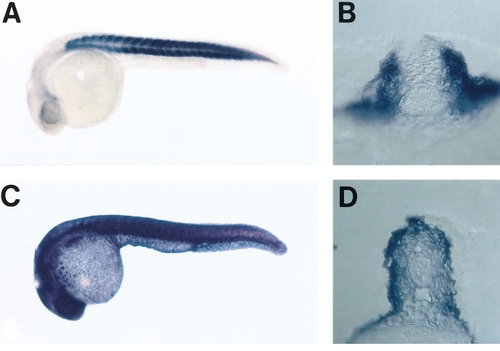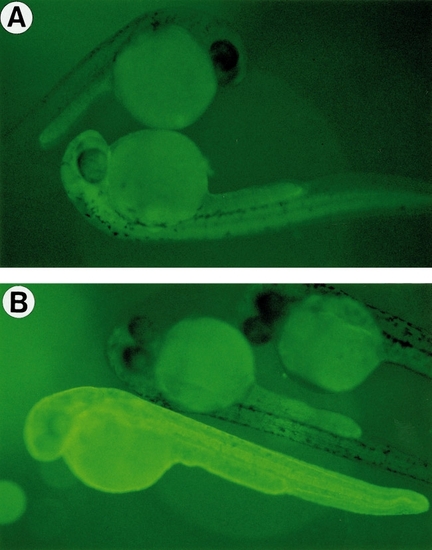- Title
-
High-frequency generation of transgenic zebrafish which reliably express GFP in whole muscles or the whole body by using promoters of zebrafish origin
- Authors
- Higashijima, S., Okamoto, H., Ueno, N., Hotta, Y., and Eguchi, G.
- Source
- Full text @ Dev. Biol.
|
Expression of α-actin and β-actin in embryonic zebrafish. One-day-old embryos were subjected to in situ hybridization using the α-actin (A and B) or β-actin (C and D) probe. A and C are whole mounts, while B and D are cross sections. EXPRESSION / LABELING:
|
|
Transient expression of GFP in α-actin–GFP-injected embryos. Embryos were viewed through their chorions. S, M, W, and X are the expression levels of GFP in each embryo. S, strong; M, moderate; W, weak; X, very weak, so that the embryo should be discarded. |
|
Expression of GFP in transgenic embryos generated using α-actin–GFP. Embryos were viewed through their chorions, except for (B) where chorions were removed. (A) 30-h-old embryos of a B-rank transgenic line. Nonfluorescent embryos are nontransgenic siblings. (B) 28-h-old embryos of C-rank and D-rank transgenic lines. A nontransgenic embryo is also shown. (C) 26-h-old embryos of an A-rank transgenic line. (D) A 13-h-old embryo of an A-rank transgenic line. (E) A 26-h-old embryo of the most fluorescent line (A-rank). Film-exposure time for this figure was much shorter than that in other figures. Due to the high fluorescence of the muscles, other regions of the embryo are clearly visible. EXPRESSION / LABELING:
|
|
Expression of GFP in transgenic embryos generated using β-actin–GFP. Chorions were removed. Nonfluorescent embryos are nontransgenic siblings. (A) A typical transgenic embryo at 28 h. (B) A transgenic embryo from the most fluorescent line at 28 h. |
Reprinted from Developmental Biology, 192, Higashijima, S., Okamoto, H., Ueno, N., Hotta, Y., and Eguchi, G., High-frequency generation of transgenic zebrafish which reliably express GFP in whole muscles or the whole body by using promoters of zebrafish origin, 289-299, Copyright (1997) with permission from Elsevier. Full text @ Dev. Biol.




